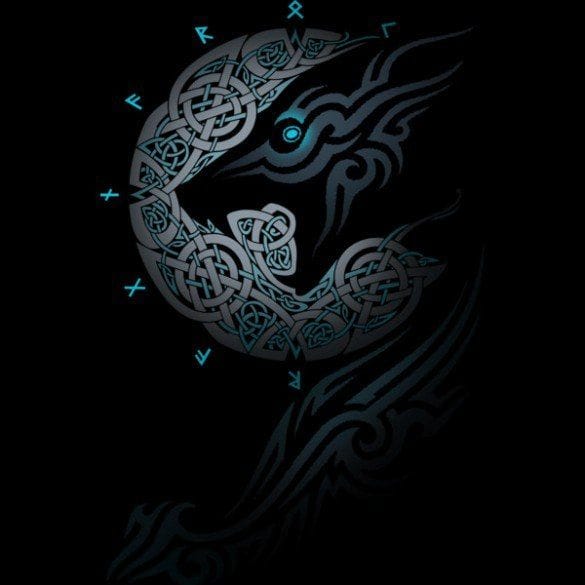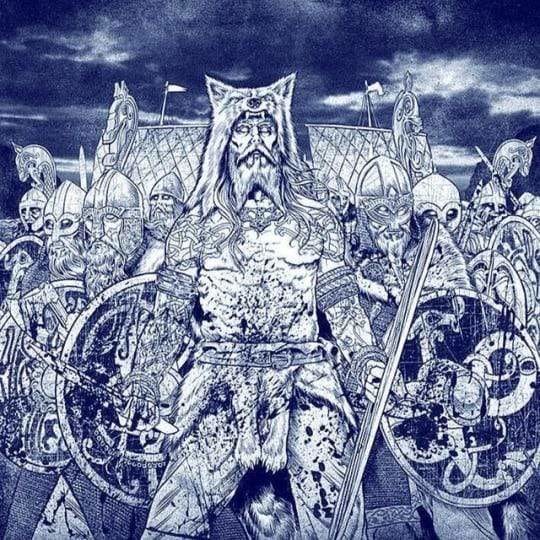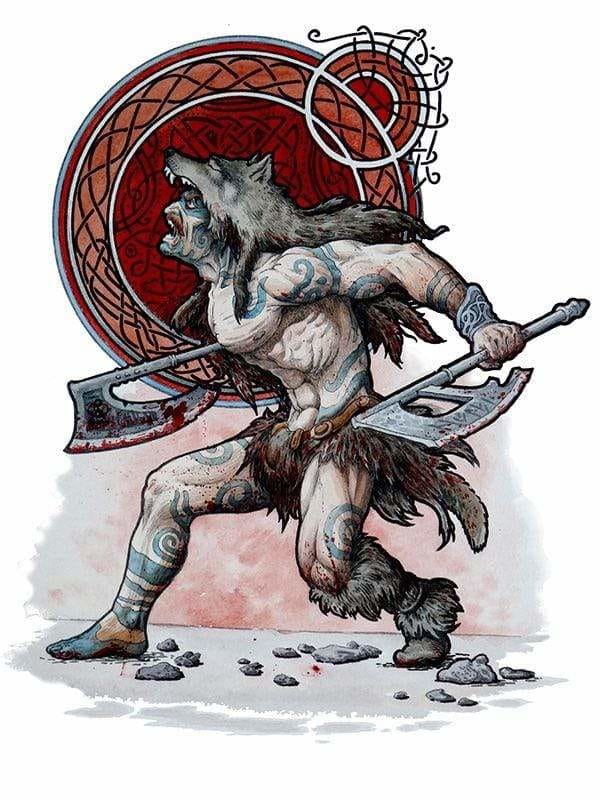Viking Wolf
Wolves were identified with warriors from at least the sixth century CE. During this time wolves and other animals began appearing as ornaments on arms and armour. Also, skalds were using wolf-kennings to describe both arms and the men who used them.
Twenty percent of known sword-kennings refer to wolves, although there are only two known axe-kennings of that type. Neither sword nor axe, however, tended to be decorated; protective gear like shields and helmets, along with trappings for horses, were the usual sites for images of animals. Perhaps they were meant to be protective.
Płuskowski suggests that through identifying with a predatory animal or a deity (Odin) associated with wolves, bears, etc., the warriors themselves became predators and their enemies, prey. One of Odin’s by-names was Hildolfr, “Battle-wolf”. Both Anglo-Saxon and Scandinavian poetry used the “beasts of battle” image, but “[i]n skaldic poetry the beasts of battle enjoy their meals!”

The next step in identification is to name oneself for the wolf, and this was not uncommon. Wolf names like Kveld-Úlfr in Egil’s saga were not uncommon, as well as many other compounds of Úlf, or just the name itself. (Bears were another popular one, and the name Björn has persisted into modern times.)
According to Helgakvida Hundingsbanna II, the descendants of King Sigmund Volsung were called Völsungs or Ylfings (Wolflings). The Ylfings got their name from the wolfish associations of Sigmundur and Sinfjötli. Of course, the Ylfings may very well be fictional, but it may be that the story of the Ylfings was supposed to reinforce family ties between the Wessex and Danish royal houses.
Gerard Breen detects a pattern whereby exiles and fugitives adopt animal names as disguises until they can return to avenge the wrongs done them. He instances the sons of Haraldus in Saxo, who “acted like hounds, wore wolf-claws as shoes, ate like hounds (sub canum specie nutriebantur) and also assumed hound names as a disguise”.
In Hrings saga ok Hringvarðar, a warrior sent to assassinate Hringur gives his name as Úlfr, which turns out to be his downfall. (Perhaps it was a bit of a giveaway.) In Egils saga as well, two assassins called Úlfr turn up. Clearly if you were expecting assassins, you just waited for someone with a bear or wolf name to turn up.

The ultimate in identification was the idea of the úlfheðnar or berserkrs, wolf-skins or bear-shirts. Both groups of warriors were greatly feared, because it was believed that they felt no pain and could not be stopped. These warriors were either seen as merely men in animal-skins, as in this example:
The berserks were roaring
For this was their battle,
the wolf-coated warriors howling,
And the irons clattering.
(Þorbjõrn hornklofi, Haraldkvaeði: 8)
The poem goes on to explain that úlfheðnar were berserks who had fought exceptionally well, so úlfheðnar was a subcategory of berserkr. Vatnsdæla saga also mentions them: “and berserks known as “Wolf-skins” – they used wolf-skin cloaks for corselelts and defended the bow of the ship.” (There were also those who had shape-shifted, which I will deal with below.) Both types of warrior identified themselves with their animals, and drew their strength from this identification.
OUTLAWS: VARGR (WOLVES)
On the other side of the coin, we have outlaws, who were also called wolves, although generally by others rather than themselves.
The word vargr or wolf was the name for an outlaw, because like wolves they had to skulk outside of human society. In Grágás, the Old Icelandic law-code, it says: “murder vargr the one who has murdered men.”
Words like mordvargr (murderer), vargtre (wolftree, gallows), vargroekr (expelled like a wolf), and vargrdropi/vargdragi (wolf cub, son of an outlaw) reinforce the connection. Ulfr for “avenger” is another such legal/metaphorical term. (Wolves and bears themselves could actually be outlawed, thus making a metaphor concrete.

Outlaws were often described as taking on a vargshamr (wolf-shape), just as Freya had her falcon-shape (Thrym.), and the maidens in Völundarkviða had swan-cloaks. The idea of an outlaw literally becoming a wolf turns up in a great deal of Old Norse literature, in the Eddas and sagas:
Gylfaginning, Hrafnagaldur Óðins, Völsunga saga, Helgakviða Hundingsbana I (Völsungakviða), Gibbons saga, Sigrgarðs saga frækna, Sigrgarðs saga ok Valbrands, the Skjöldunga saga of Arngrímur “the learned,” Ála flekks saga, Úlfhams saga, Tíódels saga, Jóns saga leikara, Sagan af Þorsteini glott, and Hvað þýðir “sár… In addition, the motif is found in two Norwegian texts that were both known and read in Iceland: a short episode in Konungs skuggsjá and the translation of the Lai de Bisclavret (Bisclaretz ljóð) in Strengleikar.
Like a wolf, the outlaw was a danger to others, and must hide in the woods like them. (The sagas, too, reflect ambivalence about berserkrs and úlfheðrin; in several stories we hear of someone having to kill them for being too disruptive, dangerous and untameable.)
Guðmundsdóttir notes that while women generally turn into attractive birds like swans or cranes (although there is shape-shifting to wolves in Völsung saga), changing into a wolf was generally a male preserve, and could be viewed in a very negative light.
WEREWOLVES MYTHS
The ultimate in danger was the werewolf, someone who could shift between states, dangerous and forward-thinking like a human, and persistent and ravening like a wolf. As Terry Pratchett’s Gaspode explains:
Humans don’t like werewolves. Wolves don’t like werewolves. People don’t like wolves that can think like people, an’ people don’t like people who can act like wolves. Which just goes to show you that people are the same everywhere,” said Gaspode. He assessed this sentence and added, “Even when they’re wolves.”
The Võlsung saga has several examples of werewolves, both innate and helped along by possession of a wolf-skin. The wolf-skins are found in the woods, significantly, by Sigmundr and Sinfjötli, who wear them for ten days, a possible initiation motif. By going outside, to the woods, and taking on the wolf-form, presumably they gain the powers of the wolf.

This outsiderness might explain why the giantess in Völuspá gives birth to wolves in Iron-Wood. Like wolves, like outlaws, the giants were outside of human and godly society, existing on the fringes. It is thus no surprise that giant-names crop up that incorporate the wolf idea:
Hlébardr “leopard” also used for bear and wolf
Úlfr “wolf”
Grímúlfr “wolf-masked”
Úlfheðinn hedinn “jacket of fur” + úlfr, “wolf”
Björgólfr “mountain-wolf”
Hrólfr hród “fame” + úlfr “wolf”
Ylfingr “wolflings”
Röndólfr rönd, “shield” + úlfr “wolf”
Sökkolfr sakka, “sink, depression” and úlfr “wolf”, dark wolf
Further, Thiazi is called wolf twice in Haustlöng, once as the “lady-wolf” because he stole Iðunn away, and once as “mountain-wolf”. Significantly, Loki is also called a wolf, in a rather complicated kenning referring to his role in stealing Iðunn: “ale-Gefn’s [Iðunn’s] flowing corpse-sea [blood] hound [wolf, thief, i.e. Loki]”.
This serves to underline Loki’s treacherous nature, as he helps the giants to strike a very damaging blow at the Æsir. From the gods’ point of view, Loki has crossed the line that separates Geri and Freki from Fenrir.

This boundary-crossing nature of the wolf — and by extension, the werewolf — becomes a potent symbol of betrayal, wildness, and untamed power in Norse mythology.
The distinction between wolves like Geri and Freki, who serve Odin, and Fenrir, who is destined to bring destruction, reflects the complex place of the wolf within the Norse worldview.
Wolves associated with the gods can be fierce yet loyal, whereas those that stand apart, like Fenrir and Loki, embody chaos and doom. Werewolves, with their dual nature, blur this boundary even further, making them figures that straddle loyalty and danger, civilization and the wild.
In Norse mythology, they serve as reminders of the thin line between order and chaos, human and beast, reinforcing that stepping beyond societal boundaries carries both power and peril.


